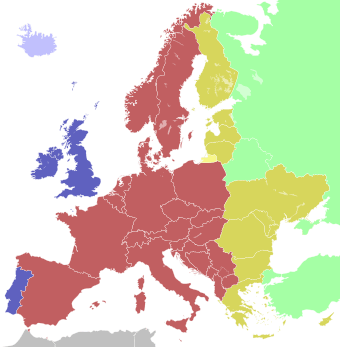Central European Summer Time facts for kids

| blue | Western European Time (UTC+0) Western European Summer Time (UTC+1) |
| light blue | Western European Time (UTC+0) |
| red | Central European Time (UTC+1) Central European Summer Time (UTC+2) |
| yellow | Eastern European Time (UTC+2) Eastern European Summer Time (UTC+3) |
| orange | Kaliningrad Time (UTC+3) |
| green | Further-eastern European Time (UTC+3), a.k.a. Moscow Time |
Central European Summer Time (CEST) is a special time zone used in many European countries during the summer. It is also known as Central European Daylight Time (CEDT). This time zone is one hour ahead of Central European Time (CET). When countries use CEST, they "spring forward" their clocks by one hour. This helps make better use of daylight.
Contents
What is Central European Summer Time?
Central European Summer Time is basically Central European Time plus one hour. So, if it's 10:00 AM CET, it would be 11:00 AM CEST. This change happens to give people more daylight in the evenings. It's a way to adjust our clocks to match the longer daylight hours of summer.
Why Do We Use Summer Time?
The main idea behind using summer time, or Daylight Saving Time, is to save energy. When it's lighter in the evenings, people might use less electricity for lights. It also means that people can enjoy outdoor activities more after work or school because it stays bright later. The idea first came up to save coal during wartime.
How Does It Work?
Countries that use CEST usually change their clocks on a specific day in spring. They move the clocks forward by one hour. Then, in autumn, they move the clocks back by one hour. This brings them back to Central European Time (CET). The change usually happens on a Sunday morning.
When Does CEST Happen?
Central European Summer Time starts in the spring. It typically begins on the last Sunday of March. On that day, at 2:00 AM CET, clocks jump forward to 3:00 AM CEST.
It ends in the autumn. This usually happens on the last Sunday of October. On that day, at 3:00 AM CEST, clocks fall back to 2:00 AM CET. This means people get an extra hour of sleep on that specific autumn morning!
Countries Using CEST
Many countries in Europe use Central European Summer Time. These are generally the same countries that use Central European Time during the rest of the year. Some examples include:
- France
- Germany
- Italy
- Spain
- Poland
- The Netherlands
- Sweden
- Norway
This system helps keep time consistent across a large part of the continent during the summer months.
See also
 In Spanish: Hora central europea de verano para niños
In Spanish: Hora central europea de verano para niños

